Dr. Sheng Peng

Dr. Peng's research focuses on fluid flow and petrophysics in unconventional reservoirs, with an emphasis on both energy security and transition. He develops integrated imaging and imbibition/injection techniques to study multi-scale processes of fluid flow and pore network characterization in shale and tight formations. He also develops and applies new laboratory and analytical methods for nano-Darcy level permeability, relative permeability, resistivity, and shale wettability measurements. The integration of laboratory techniques and multi-scale imaging in Dr. Peng's Unconventional Petrophysics Lab offers a unique approach to comprehensively understanding multiphase fluid flow (gas, scCO2, water, and oil) and the underlying pore system in unconventional reservoir rocks.
Areas of Research
We investigate the fundamental properties, mechanisms, and dynamics of fluid flow in unconventional reservoirs, such as shale, tight rocks, and other unconventional resources, including mafic/ultramafic rocks. Our research delves into the pore and fracture/microfracture systems within these rocks, exploring fluid flow dynamics (gas, CO2, water, and oil) and phase distribution across multiple scales (nano-to-centimeter) within specific geological formations. Our findings contribute to reservoir evaluation, enhanced oil production, water management, and carbon utilization and storage in unconventional reservoirs.
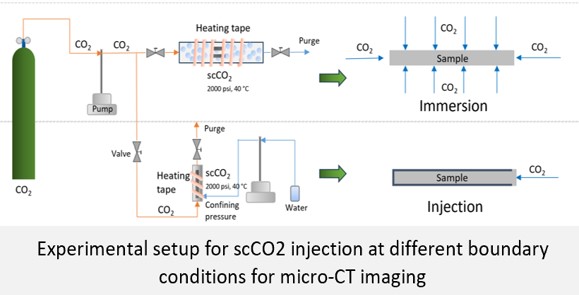
Supercritical CO2 sweeping efficiency in shale for enhanced oil recovery and CO2 storage
Enhanced oil recovery is imperative for sustaining oil production given the rapid decline of primary production in shale. The utilization of CO2 as an injected gas holds significant promise due to its advantageous properties, such as low miscible pressure with oil and reduced interfacial tension. Additionally, CO2 injection offers the opportunity for carbon storage, reducing the carbon footprint associated with incremental oil production. (Read more)
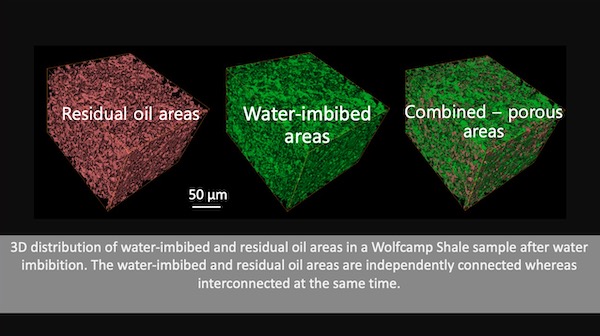
Water-oil displacement and wettability in shale
Water-oil displacement is an important process that occurs at several scenarios in shale oil production, whereas the fundamental mechanisms and controlling factors, including wettability, are unclear in shale. This process is investigated on the basis of an integrated method of imbibition and multiscale imaging, which provides a more complete and specific understanding of the water-oil flow and the underlying pore systems in shale. Many new insights on wettability and the strategies of improved oil recovery in shale have been gained through this work. (Read more)
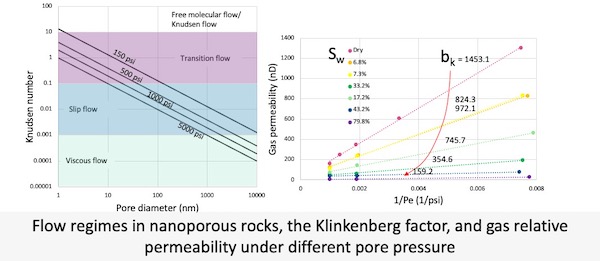
Gas flow and the Klinkenberg effect in nanoporous rocks
Gas flow in nanoporous rocks is closely relevant to several energy and environmental issues, and the Klinkenberg effect is critical to an understanding of gas flow. We investigated gas flow and the Klinkenberg effect in nanoporous rocks based on a systematic study of gas permeability and diffusivity under a range of pore pressures and water saturations. New insights obtained through this work can advance the understanding of gas flow in nanoporous rocks and will have important implications on industrial applications. (Read more)
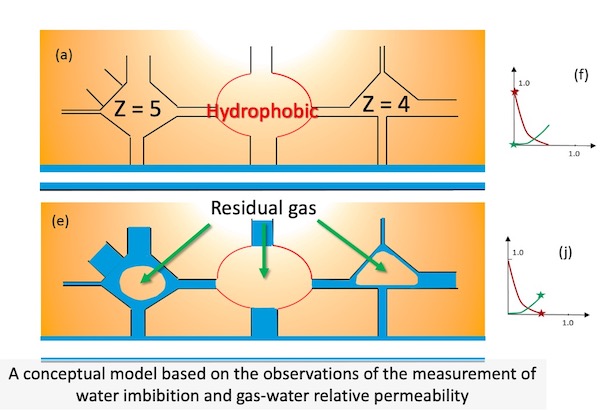
Gas relative permeability and hysteresis in shale
Relative permeability has a significant impact on gas or oil and water production, but is one of the most complicated properties in unconventional reservoirs. Current understanding on relative permeability for unconventional reservoir rocks is very limited, mainly because of a lack of direct measurement of relative permeability for these rocks that have matrix permeability of sub-micron-Darcy level. In this project, a modified gas expansion method for shale matrix permeability measurement was adopted to measure gas relative permeability directly under the scenarios of water imbibition and drainage for samples from different unconventional reservoir formations. We also investigated the influence of the gas-water relative permeability hysteresis and water block effect on the gas and water production after shut-in. (Read more)
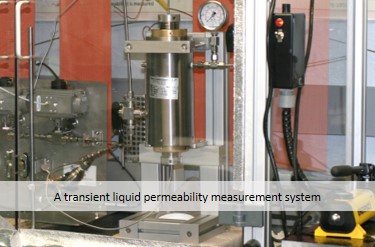
Liquid permeability and relative permeability in shale
Liquid permeability can be obtained through gas permeability and the Klinkenberg correction for conventional reservoir rocks, whereas such practice does not work for unconventional reservoir rocks. Direct measurement of liquid permeability (oil or water) is needed for a more accurate representation of the liquid flow capacity in the rocks. A liquid permeability measurement system using a transient method has been established in UPL.
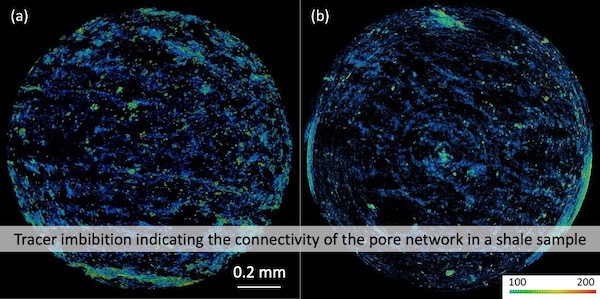
Pore network connectivity, heterogeneity, and upscaling in shale
We started our studies in shale from the pore network characterization and permeability estimation. Understanding of the underlying pore system and its geological characteristic and control is essential to the understanding of fluid flow and water/gas/oil distribution. Nano-scale pores and heterogeneity in the surface composition pose the unique challenge in the study of shale. (Read more)
Education
Ph.D. Environmental Hydrogeology, University of Arizona, 2004
M.S. Environmental Science, Beijing Normal University, 2000
B.E. Environmental Planning and Management, Suzhou Institute of Urban Construction & Environmental Protection, 1997
Professional History
Research Associate Professor, Bureau of Economic Geology, The University of Texas at Austin, 2024–present
Research Scientist, Bureau of Economic Geology, The University of Texas at Austin, 2021–2023
Research Associate, Bureau of Economic Geology, The University of Texas at Austin, 2014–2021
Research Fellow, Bureau of Economic Geology, The University of Texas at Austin, 2013–2014
Assistant Research Professor, Department of Earth and Environmental Sciences, The University of Texas at Arlington, 2011–2013
Associate Professor, School of Environment, Beijing Normal University, 2007–2010
Project Hydrogeologist, GeoSystems Analysis, Inc., Tucson, Arizona, 2005–2007
Post-doctoral Researcher, University of Arizona, 2004–2005
Assistant Environmental Engineer, Sound Environmental Engineering Group, Beijing, 2000–2001
Select Publications
Peng, S., 2023. Evaluating the accuracy of liquid permeability measurements in shale and tight rocks using transient flow method and comparison with gas permeability. Marine and Petroleum Geology 157, 106491.
Peng, S., LMR Maraggi, S. Bhattacharya, K. Yut, T. McMahon, M. Haddad, 2023. Feasibility of CO2 Storage in Depleted Unconventional Oil and Gas Reservoirs: Capacity, Microscale Mechanism, Injectivity, Fault Stability, and Monitoring. Unconventional Resources Technology Conference, June 13-15, Denver, Colorado. (Media coverage by AAPG Explorer and The American Oil & Gas Reporter on this work)
Peng, S., P. Shevchenko. L. T. Ko, 2022. Shale Wettability: Untangling the Elusive Property with an Integrated Imbibition and Imaging Technique and a New Hypothetical Theory. SPE Reservoir Evaluation & Engineering. https://doi.org/10.2118/212276-PA
Peng, S., J. LaManna, P. Periwal, P. Shevchenko, 2022. Water Imbibition and Oil Recovery in Shale: Dynamics and Mechanisms Using Integrated Cm-to-Nm-Scale Imaging. SPE Reservoir Evaluation & Engineering. https://doi.org/10.2118/210567-PA
Peng, S., Shevchenko, P., Periwal, P. et al. 2021. Water-Oil Displacement in Shale: New Insights from a Comparative Study Integrating Imbibition Tests and Multiscale Imaging. SPE J. SPE-205515-PA. https://doi.org/10.2118/205515-PA. Also presented in URTeC 2021.
Peng, S., 2021. Advanced understanding of gas flow and the Klinkenberg effect in nanoporous rocks, Journal of Petroleum Science and Engineering, 109047. https://www.sciencedirect.com/science/article/pii/S092041052100704X
Peng, S, 2020. Gas-Water Relative Permeability of Unconventional Reservoir Rocks: Hysteresis and Influence on Production after Shut-in. Journal of Natural Gas Science and Engineering. doi:10.1016/j.jngse.2020.103511. (This paper was presented at URTeC 2020 prior to publication)
Peng, S., Y. Liu, L. Ko, W. Ambrose, 2019. Water/Oil Displacement by Spontaneous Imbibition Through Multiscale Imaging and Implication on Wettability in Wolfcamp Shale, Unconventional Resources Technology Conference, July 22–24, 2019, Denver, Colorado, doi:10.15530/urtec-2019-194.
Peng, S., 2019. Gas Relative Permeability and Evolution during Water Imbibition in Unconventional Reservoir Rocks: Direct Laboratory Measurement and A Conceptual Model. SPE Reservoir Evaluation & Engineering-Formation Evaluation, SPE-198896-PA, doi:10.2118/198896-PA.
Peng, S., R. Reed, X. Xiao, Y. Yang, Y. Liu, 2019. Tracer-Guided Characterization of Dominant Pore Networks and Implications for Permeability and Wettability in Shale, Journal of Geophysical Research – Solid Earth, doi:10.1029/2018JB016103.
Peng, S., B. Ren, M. Meng, 2019. Quantifying the Influence of Fractures for More Accurate Laboratory Measurement of Shale Matrix Permeability using a Modified Gas Expansion Method, SPE Reservoir Evaluation & Engineering-Formation Evaluation, SPE-195570-PA, doi:/10.2118/195570-PA.
Peng, S, T. Zhang, R. Loucks, J. Shultz, 2017. Application of mercury injection capillary pressure to mudrocks: Conformance and compression corrections. Marine and Petroleum Geology, vol. 88, p. 30–40, doi:10.1016/j.marpetgeo.2017.08.006
Peng, S, and X. Xiao (2017). Investigation of multiphase fluid imbibition in shale through synchrotron-based dynamic micro-CT imaging, J. Geophys. Res. Solid Earth, vol. 122, doi:10.1002/2017JB014253.
Peng, S, A. Hassan, R.G. Loucks, 2016. Permeability estimation based on thin-section image analysis and 2D flow modeling in grain-dominated carbonates. Marine and Petroleum Geology, vol. 77, p. 763–775, doi:10.1016/j.marpetgeo.2016.07.024.
Peng, S., B. Loucks, 2016. Permeability measurements in Mudrocks using gas-expansion methods on plug and crushed-rock samples. Marine and Petroleum Geology, doi:10.1016/j.marpetgeo.2016.02.025.
Peng, S., J. Yang, X. Xiao, B. Loucks, S. Ruppel, T. Zhang, 2015. An integrated method for upscaling pore-network characterization and permeability estimation: Example from the Mississippian Barnett Shale. Transport in Porous Media, vol. 109, no. 2, p. 359–376, doi:10.1007/s11242-015-0523-8.
Peng, S., F. Marone, S. Dultz, 2014. Resolution effect in X-ray microcomputed tomography imaging and small pore's contribution to permeability for a Berea sandstone. Journal of Hydrology, vol. 510, 403–411.
Peng, S., N. Wang, J. Chen, 2013. Steam and air co-injection in removing residual TCE in unsaturated layered sandy porous media. Journal of Contaminant Hydrology, vol. 153, p. 24–36.
Peng, S., S. Dultz, M. Zhang, Q. Hu, 2012. Pore structure characterization of Berea sandstone using synchrotron X-ray computed tomography: resolution effect and comparison with mercury intrusion porosimetry. Journal of Hydrology, vol. 472, 254–261.
Peng, S., Q. Hu, R. P. Ewing, C. Liu, and J. M. Zachara, 2012. Quantitative 3-D elemental mapping by LA-ICP-MS of basalt from the Hanford 300 area. Environmental Science & Technology, vol. 46, p. 2035–2042.
Peng, S., Q. Hu, S. Hamamoto, 2012. Gas diffusivity in rocks: measurement and its correlation to porosity, pore-size distribution, and permeability. Water Resources Research, vol. 48, no. 2, p. W02507, doi:10.1029/2011WR011098.
Peng, S, Wu, W., Chen, J., 2011. Removal of PAHs with surfactant enhanced soil washing: Influencing factors and removal effectiveness. Chemosphere, vol. 82, p. 1173–1177.
Peng, S. and M. L. Brusseau, 2005. The impact of soil texture on air-water interfacial area in unsaturated sandy porous media, Water Resources Research, vol. 41, no. 3, p. W03021, doi:10.1029/2004WR003233.
Services
Associate Editor, SPE Reservoir Evaluation & Engineering, 2019–present